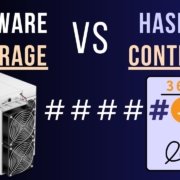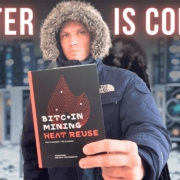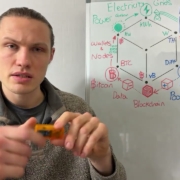How Subsidy changes the VALUE of your Bitcoin?! | Hashpower Academy
Welcome to Hashpower Academy, where we unpack Bitcoin’s value shifts. In “How Subsidy Changes the VALUE of Your Bitcoin?!,” we dive into subsidies, fees, and what pumps your BTC’s worth.
What’s Covered:
Subsidy basics: Block rewards price against miners energy and hashrate.
Halving effect: Every 4 years, energy reprices—BTC buying power jumps.
Fees rising: Data storage in blocks drives fees, not BTC amount.
Fee takeover: When subsidies fade, fees rule the game.
Fee surges: Quantum wallet shifts could spike activity big-time.
Key Insights:
Energy link: Halvings cut subsidy, hike BTC’s energy value.
Fee shift: Data size matters—more bytes, more fees.
Quantum push: Moving to secure wallets = fee market boom.
Miner pivot: From subsidy cash to fee-driven future.
Why Watch:
See how halvings juice your Bitcoin’s power.
Prep for the fee era—and quantum’s wild ride.
Join Hashpower Academy to decode BTC’s value evolution—watch now and stack smarter!
Financial Disclaimer:
This video serves educational and informational purposes only and should not be construed as financial advice or investment recommendation. The views expressed are those of the presenter and do not represent Hashpower Academy’s official stance. Information is provided ‘as is’ without warranties, express or implied, as to its accuracy or completeness. Engaging with Bitcoin involves high risk, including potential financial loss, market volatility, and energy costs, and is suitable only for those who can bear these risks. Always conduct your own research and consult with a qualified financial or technical advisor before making decisions related to Bitcoin.
#bitcoin
#Quantum
#Crypto
#BitcoinMiners
#Subsidy
#BitcoinFees
#Halving
#BTC
#traders
#Economics
#BitcoinValue
#Mining
#CryptoTraders
#FeeMarket
#Blockchain
#BitcoinPrice
#QuantumResistance
#CryptoMining
#BTCSubsidy
#BitcoinFuture
Video Transcript:
hello there and welcome to the hash power Academy this is a place for you to learn anything and everything to do with Bitcoin and it’s fundamental layers of Technologies and commodities and the context of today’s video is subsidy is inevitably trending to zero every four years the amount of Bitcoin per block per 10 minutes every four years that cuts in half and the amount of Bitcoin distributed to those miners consuming energy on the grids producing that compute to earn all of that Bitcoin per day well if the amount of Bitcoin per day Cuts in half and the amount of electricity they consume stays the same well their production cost doubles and the amount of Bitcoin that you need to use to purchase that electricity think of it the other way around well that increases so the harving event essentially doubles your purchasing power we’ll get into that later in the video so the typical approach here is to understand that subsidy and fees represent the total block rewards so every time a miner finds the next block in the chain they earn the quantity of subsidy which right now is 3.125 Bitcoin and they earn some fees which I’m being generous and writing 0.1 and so this represents a massive dichotomy between the amount of subsidy per block being over 95 plus% of block reward and the 5% being fees and again that’s generous it’s typically about 90 8% subsidy so this is to say that the 98% component of what miners are being paid is inevitably going to cut in half and then four years later cut in half again again and again again so their revenue is trending to zero and what we want is fees to increase so I have drawn the 0.1 Bitcoin in blue here this line and this is to say that when fees take over the majority of the block block rewards is going to be in about 20 plus years time from now when there’s multiple harving enough to the point where 0.1 uh is enough that it’s more than 50% of the block that they earn and subsidy represents issuance it’s just inflation of the full 21 million Bitcoin being uh issued into circulation and fees represent economic activity because when you send some Bitcoin you pay a fee and that fee represents not the quantity of Bitcoin that you send if you send more send less you don’t pay more unless the transaction data is more your paying for storage space of data and Bitcoin per VTE is the original unit of account pricing system for Block space the amount of data storage that you use to store your transaction information now what we want in an ideal world is more stimulation of economic activity on the consumption monetary side of Bitcoin so that the amount of fees per block were to increase and what we want is a point in which fees are more than subsidy and I believe this is a change um in the circumstances of Bitcoin to where we shift more away from a store of value phase and more onto a medium of exchange which probably does correlate to these sorts of Market phases the the store of value phase is people’s dollariz perception of Bitcoin just absolutely shooting up its own scurve think of it like a bell curve here and the medium of exchange phase that point in which subsidy drops below fees that could represent a medium of exchange aspect and when the majority of block rewards to miners are mostly fees well that could be the unit of account phase um and these three phases represent the full S curve with the steepest part being here and that truly correlates to the amount of adoption curve we we will see I believe because we’re at such a low percentage of adoption the amount of energy that the network consumes relative to Global energy is a very nominal percent and the amount of settlement on the Block space side of things in transaction settlement is still very low the market cap of Bitcoin and dollarized terms still very low and so there is a lot of upside potential for a global monetary system based on energy and the whole aspect of subsidy inevitably trending to zero means that miners will need to stimulate more economic activity in the network to ensure that fees per block overtakes the subsidy in relative time and this inevitable Trend to zero means that well subsidy is fixed issuing that full supply of 21 million and fees can continually increasing there are several reasons why fees could massively increase and one of them is actually to do with Quantum Computing because what happens is if we need to update the Bitcoin blockchain to have Quantum resistant wallets and messaging systems within the blockchain well you would have to move all of the old Bitcoin and old wallets into new Quantum resistant wallets and so you have this limit of all of this data that could not just the Bitcoin as money but also data each transaction and quantity stored in different wallets is a certain amount of data that would need to move through and settle in Bitcoin blocks and if it’s limited and constrained to 144 per day well there’s going to be a lot of people fighting to get in the next lift which is a good analogy for understanding the fee Market because the fee Market works in the sense of uh a long line of people waiting to get in a lift that comes every 10 minutes and there’s only so much space in the lift so everyone’s um bidding with I’m willing to pay this quantity of Bitcoin I’m willing to pay this quantity and the size of the transaction is essentially the size of the person uh the amount of space that you fill in the lift so your you’re paying for the space and you’re paying for the the privilege of more Bitcoin to to be the first in the block because the Bitcoin blockchain interestingly enough if uh if you’re not settled in space because you’ve not paid a high enough fee your transaction is stored in time it’s put into the next block into the next block and you can use uh websites such as mempool dospace as a really good uh UI to understand what the blockchain’s doing right now and all the different pricing systems but yeah the overall approach here is this if the amount of Bitcoin per block is mostly subsidy and this in in introduces a pricing system where uh when miners want to sell the power back to the grid they are comparing it to this amount of Revenue that they can earn on the digital side if the amount of Bitcoin per kilowatt or megawatt is more favorable by selling it locally they just switch the machines off or scale the machines down they can underclock them and if the amount of Bitcoin they earn continually drops it means that they’re going to be willing to sell that electricity at a lower and lower price so when everyone talks talks about Bitcoin taking over and stealing everyone’s energy no in fact actually they’re going to try and build out as much more compute and it’s going to get continually priced cheaper and cheaper over time at a price that they are willing to sell it and you holding Bitcoin well if the amount of Bitcoin exchanged into energy keeps getting cheaper over time you got to flip this the other way around it means you now need less Bitcoin to buy the energy and over time this works as a new pricing system because there’s math ma matical layers between all of this it’s all intrinsically connected through physics maths and finance I hope this was an interesting video I hope you enjoy and I will see you in the next one goodbye














Leave a Reply
Want to join the discussion?Feel free to contribute!